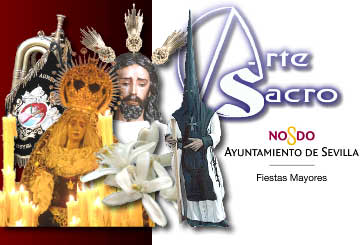
![]()

(La Madrugá) The Early Hours of the
Morning.-
 |
(La Madrugá) The Early Hours of the
Morning.- |
|
In Seville, this is the day of Easter Week when the most important artistic and emotional elements of the Fraternities come together. During the night of Holy Thursday and the morning of Good Friday and well into the day, the city is a beehive of people and emotion. The vigil produces a strange sensation in which yesterday and today fuse together and undoubtedly helps to create a mysterious atmosphere which seems to envelop the city. From the time when the first Fraternity of the "Madrugá", Ntro. Padre Jesus Nazareno, El Silencio (The Macarena exit at 00:00 AM from her Basilica), until the last floats leave (Esperanza de Triana and Macarena) at about 13:30 PM on Good Friday, more of twelve hours have gone by. For this reason, we suggest two ways of experiencing the Madrugá:
b) Relax during the night before taking to the streets at about 04:00 or 05:00 AM. Know how to take "La Madrugá", since the crowd, the night, the cold and other factors, turn it into a night very different to the rest. To begin, the six fraternities that make penance could be divide in two groups: those of black and those of cloak. It is the night of the contrasts: on one hand the rhythmic and acclaimed marches, by the multitude, on the other hand chapel music and the firmest silence. This night it represents the zenith of the Holy Week, perhaps the most important note in the sevillian fervour, although not all what that we see that night is of our pleasure. We will see the most representative images in the Passion. The Silence's Christ that doesn't allow rest, since seems to run, while he hugs its tortoiseshell and silver cross, the one only invested with regard to the other ones.
It is, par excellence, the other side of the night, the change of the candles on high for the feathers of the armaos. After her, the silence come back, the Calvario Fraternity, that puts in order the bustle and restore seriousness immediately. After him, another Hope's Virgin, but this time from the Triana's Fraternity and under a rain of petals that shock the Tetuan street, just before the entrance in the Official Route. The night is closed by The Gitanos' Christ that with his Cross on the back, travel "La Campana" (The Bell) Square in a single but slow chicotá, to the sounds of the marches which are chained each other. The moment of thinking about how and when it is better to see those of Dawn arrives, to continue the night of good Thursday, or to get up early and go out when Good Friday shows its first hours of life, in both cases, we can try to see the six fraternities. Perhaps for old people and those that go accompanied by children, it is better to get up early since the great majority since has already come back home to rest. Tips for getting through The Madrugá.-
Although it may seem strange, stopping to relax halfway through the night can have devastating effects when tiredness gets the better of us. If necessary, it is better to have a coffee in a bar (all of the centre of the town are open that night) and keep going as long as you can. Just as the early morning represents the most intense moment as far as devotion, art and emotion are concerned, it is also true for the hussle and bussle in the streets and the number of nazarenos. This involves unavoidable waiting to see the floats, particularly in the very early hours of the morning. Be patient and enjoy watching the processions (nazarenos, acólitos, banners, etc…) some of which are the most interesting of Easter Week. And don't forget something very important for this night, the patience, since you will be able to check how you are gobbled literally by people's uproar that tries to move from a place to another to contemplate as close as possible to their fraternities, or you will be able to despair before the endless nazarenos retinue that passes in front of you and it seems never to finish.
|
|
|
Copyright 2004 Arte Sacro© www.artesacro.org - All rights reserved. |
|
|
Made in Seville - Spain |